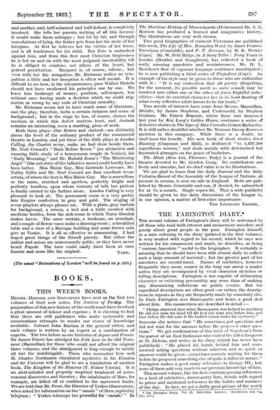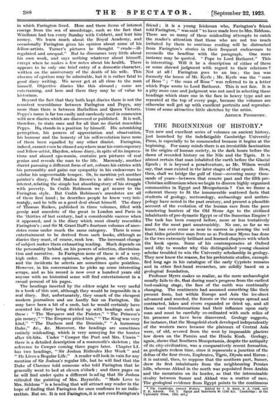THE FARINGTON DIARY.*
THE second volume of Farington's diary will be welcomed by all those who read with interest and amusement anecdote and gossip about great people in the past. Farington himself, in a note referring to the diary (printed in the first volume), is very modest with regard to his record, which lie says was written for his amusement and much, he describes, as being " curious Anecdote " useful to the biographer. It certainly is amazing that lie should have been able almost daily to collect such a large amount of material ; but the greater part of his anecdotes are second-hand. Names of celebrities, however frequently they occur, cannot in the long run arrest a reader unless they arc accompanied by vivid character sketches or telling descriptions. Farington is not capable of delineating character or criticizing personality any more than of making any illuminating reflections on public events. But his superficial descriptions arc often good—or rather, the descrip- tions lie repeats as they are frequently made by somebody eLse. In Paris Farington sees Buonaparte and hears a good deal about him. His mannerisms are described in detail :— " Philips observed that when Buonaparte was helped to anything He did not raise his head till He had eat what was before him, and that before He did raise it He looked round under his eyebrows." Someone else notices that " He sometimes put questions and
did not wait for the answers before He proposed other ques- tions." We get confirmation of this trick of Napoleon's from the purser of an East Indiaman who visited the fallen Emperor at St. Helena, and writes in his diary (which has never been published) : " He placed his hands behind him and com- menced asking questions without selection and as quick as answers could be given—sometimes scarcely waiting for them before he proposed something else of quite a different nature."
Farington makes a good many references to George III., but
none of them add very much to our previous knowledge of him. This second volume, like the first, contains passing references to a host of celebrities, dinner-party lists, details with regard to prices and incidental references to the habits and manners of the day. In fact, we get a fairly good picture of the world
• The Paritiaioa Diary. Vol. 11. 1802-1804. London : llutcblmou and GoE [21s. net.] in which Farington lived. Here and there items of interest emerge-from the sea of anecdotage, such as the fact that Windham had tea every Sunday with Cobbett, and lent him money. We learn much about the Royal Academy, and occasionally Farington gives his opinion about some of his fellow-artists. Turner's pictures he thought " crude—ill- regulated and unequal." But he discourses very little about his own work, and says nothing whatever about himself, except when he makes a few notes about his health. There appears to be only one brief entry of a domestic character, written on the anniversary of the death of his wife. This absence of egotism may be admirable, but it is rather fatal to good diary writing. We never get at all close to the man himself. Objective diaries like this abound ; some are entertaining, and here and there they may be of value to historians.
Beyond the fact that they both kept diaries there is not the remotest resemblance between Farington and Pepys, any more than there is between Barbellion and Queen Victoria. Pepys's name is far too easily and carelessly used in connexion with new diaries which are discovered or published. It is well, therefore, to state once and for all that no diarist resembles Pepys. He, stands in a position by himself. His astonishing perception, his powers of appreciation and . observation, his humour and the honesty of his self-revelation have none of them been equalled by any other diarist. Farington, indeed, cannot even be classed anywhere near his contemporary and fellow-artist, Haydon, whose diary, in spite of its impreca- tions - and absurd ego-mania, contains pen pictures of real genius and reveals the man to the life. Macready, another diarist pursuing a different form of art, colours his entries with his personality and gains our sympathy in his endeavours to kubdue his ungovernable temper. Or, to mention yet another painter's diary, Ford Madox Brown's is alive with human interest, relating the simple but absorbing story of his struggle with poverty. In Crabb Robinson we get nearer to the Farington style. But Crabb Robinson's anecdotes are all of them first hand ; he describes people he knew very inti- mate,y, and he tells us a good deal about himself. The diary of Thomas Raikes, published in three volumes, filled with gossip and anecdote of the great in London and Paris in the 'thirties of last century, had a considerable success when it appeared, and is the diary which most closely resembles Farington's ; and Sir M. Grant Duff's fourteen volumes of anec- dotes come under much the same category. There is some entertainment to be derived from such books, although as diaries they must, of course, rank low. The incessant change of subject makes them exhausting reading. Much depends on the personality behind, on his powers of selection, discrimina- tion and narrative. In Farington none of these is of a very high order. His own opinions, when given, are often trite, and the incidents he selects are sometimes quite pointless.
However, in his conversations he picks up some interesting scraps, and as his record is now over a hundred years old anyone with an historical sense will find entertainment in a casual perusal of his pages.
The headings inserted by the editor might be very useful in a book of this sort, although they would be impossible in a real diary. But, unfortunately, they smack of the cheapest modern journalism and are hardly fair on Farington. He may have been a bit of a snob, but he would certainly have resented his diary being divided up with headings such as these : " The Marquess and the Painter," " The Princess's pin money," " The Empress pitied him," " The King was very kind," " The Duchess and the Dominie," " A humorous Duke," &c., &c. Moreover, the headings are sometimes entirely misleading, which is very annoying for the hunter after tit-bits. Under " Cowper the Poet and Mrs. Unwin " there is a detailed description of a mammoth's skeleton ; the reference to Cowper coming three pages later. Chapter LI.
has two headings, " Sir Joshua Ridicules Her Work " and " He Lives a Regular Life." A reader will look in vain for any mention of Sir Joshua's regular life, but he will find that the Duke of Clarence told someone who told Farington that he generally went to bed at eleven o'clock ; and three pages on he will find under quite a different heading that Sir Joshua
ridiculed the painting of Mrs. Reynolds. " Made Love to Mrs. Siddons " is a heading that will attract any reader in the hope of finding that Farington for once confesses to an indis- cretion. But no. It is not Farington, it is not even Farington's friend ; it is a young Irishman who, Farington's friend told Farington, " was said " to have made love to-Mrs. Siddons. There are so many of these misleading attempts to catch the reader's attention that those who are not too much irritated by them to continue reading will be distracted from Farington's stories in their frequent endeavours to reconcile the headline with the paragraph. One more instance may be quoted. " Pope to Lord Bathurst." This is interesting. Will it be a description of either of them or some shrewd judgment with regard to their relations ? Not at all I Farington goes to an inn ; the inn was formerly the house of Mr. Kyrle ; Mr. Kyrie was the " man of Ross " ; " the man of Ross " was referred to in a letter which Pope wrote to Lord Bathurst. This is not fair. It is a pity more care and judgment was not used in selecting these headings which stare one in the face in heavy type and are repeated at the top of every page, because the volumes are otherwise well got up with excellent portraits and reproduc- tions of some attractive little sketches by the artist.
ARTHUR PONSONBY.







































 Previous page
Previous page